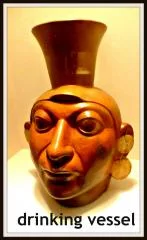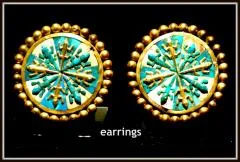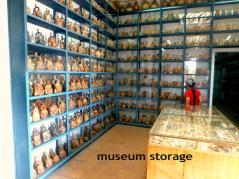Lima’s fabulous Larco Museum offers glimpse into South America’s past
Editor’s note: To save time on their 90-day T3 passport visa stamps so they could monitor construction progress on their Cuenca condo, Chiyemi and Terry Doyle were recently forced into temporary exile from Ecuador. They cooled their heels in Peru and Colombia until they returned to Cuenca, checking out the attractions of Lima, Bogota and Medellin. Here, Terry recounts a trip to the Larco Museum in Lima in the first installment of a four-part series. Chiyemi and Terry divide their time between Ecuador and Oregon.
By Terry Doyle
On a slight rise, one of the few in Lima, a city of nearly 9 million which runs along the Pacific Ocean in central Peru, lies the Larco Museum, surely one of the finest ethnological* art museum in the world.
The museum offers a dazzling history lesson in the cultures of pre-Columbian South America as well as of the Spanish conquest of the Americas.
After Francisco Pizarro and his 13 men landed on the South American west coast in 1528, defeating 5,000 Inca soldiers and taking Inca King Atahualpa prisoner, they demanded a huge ransom in gold. Once it was dutifully delivered, the Spanish violated the trust of the region’s indigenous people (not for the last time) by executing Atahualpa, and then shipped tons of gold, much of it melted down from Incan artifacts, back to Spain to fuel the Spanish Armada and decorate the churches of Spain.
5,000 Inca soldiers and taking Inca King Atahualpa prisoner, they demanded a huge ransom in gold. Once it was dutifully delivered, the Spanish violated the trust of the region’s indigenous people (not for the last time) by executing Atahualpa, and then shipped tons of gold, much of it melted down from Incan artifacts, back to Spain to fuel the Spanish Armada and decorate the churches of Spain.
Although the seven tons of gold used to cover what was once the largest church in the world, the cathedral of Seville, left Peru with less gold, there was still plenty of it left, including artifacts, that remain unparalleled in the new world. The Seville cathedral’s retablo, or altar-piece, the life-work of Pierre Dancart, is a marvel to behold, it contains hundreds of carved wooden Biblical figures slathered with Peruvian gold; the the loss of Inca gold work is worth pondering.
The Museo Larco (Museo Arqueológico Rafael Larco Herrera) was lightly attended the day we arrived after much wandering by our geographically challenged cab driver. We paid our $11.50 entry fee and set about the task of seeing a small part portion of the collection of thousands of pieces of pre-Columbian pottery, gold, silver, fabric, jewelry, stonework and more. It’s also possible to take Tripadvisor’s recommended 4.9-star package tour for $132 tour (travel tip: save your bucks by taking a taxi and you can stroll the nearby downtown historic district as well as visit the museum). Tripadvisor rates the Larco Lima’s #1 attraction and it’s easy to see why.
The Larco offers snapshots into the pre-photographic past of the Inca, Moche, Vicus, Nazca and a dozen other groups. The glass-encased pottery vessels and figurines, offer a glimpse into rich, vibrant cultures long-gone and we marveled at their breadth and depth. There are pots, colored, knotted string quipu (the equivalent of early day spreadsheets that kept track of the commerce of the Inca empire), mugs, heads, bodies (more on that in a bit), figures, priests, rulers, musicians, animals and nature: a staggering display for those interested in pre-Columbian artifacts.
into rich, vibrant cultures long-gone and we marveled at their breadth and depth. There are pots, colored, knotted string quipu (the equivalent of early day spreadsheets that kept track of the commerce of the Inca empire), mugs, heads, bodies (more on that in a bit), figures, priests, rulers, musicians, animals and nature: a staggering display for those interested in pre-Columbian artifacts.
To get you started, there’s a 10-minute professionally produced film, including animation, that gives historical context and meaning to the exhibits. We started in the storage gallery, the Larco being one of the few museums in the world that opens its extensive (larger than the primary exhibits) backroom collection to the public. We then joined an English-language tour until it went too fast for photos (no flash allowed) and real appreciation, and then to the “bodies” mentioned above. Much our group ordered lunch in the excellent restaurant in a beautiful garden setting while I went off to see what I thought was the ethnographic collection. Funny, I thought what I’d been looking at was ethnography.
“bodies” mentioned above. Much our group ordered lunch in the excellent restaurant in a beautiful garden setting while I went off to see what I thought was the ethnographic collection. Funny, I thought what I’d been looking at was ethnography.
What the museum docent had actually said was “pornografía”. Oh, my! Five seconds after entering the separate wing near the sunken restaurant it was obvious just how imperfect my Spanish was. Within a few minutes, my camera’s SD card was nearly full, a light curl of smoke rising from the camera’s electronics; this before going to get my partner to show her the marvels of indigenous sex life, replete in every possible, and some impossible detail, showing the rich sexual  imagination of indigenous people pre-Columbus. At least I hope they were impossible: animals, skeletons, men, women, gods and admixtures of all of those in postures one would think beyond physiological abilities of vertebrate species.
imagination of indigenous people pre-Columbus. At least I hope they were impossible: animals, skeletons, men, women, gods and admixtures of all of those in postures one would think beyond physiological abilities of vertebrate species.
The museum itself is beautifully laid out with displays explicated in both Spanish and English – it houses over 38,000 pieces in all. We had a great lunch, bought a catalog in the gift shop and then, after four hours of taking in as much as we could handle, headed back to our hotel in the Miraflores neighborhood, on cliffs overlooking the Pacific Ocean, consumed by thoughts about cultures dating back 2,000 years. The Inca’s loss to the conquistadores was enormously significant and the artifacts displayed in the Larco are truly a treasure for humanity. Don’t miss it.
Round-trip air fares to Lima from Cuenca run roughly $370; Airbnb lodging $35 per night, and up.
* Ethnology, a branch of anthropology is the study of human culture comparative religion, language, science, technology and art.
Terry Doyle is hosting a Cuenca Explorers tour to the Pawkar Raymi celebration in Saraguro March 20 to 24. Those interested in joining can contact Terry at terrydarc@gmail.com for more information.





















